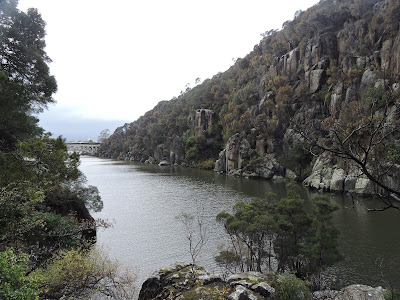We woke to intermittent rain, but that didn’t stop us from
taking a 2.5 mile walk through Launceston to Cataract Gorge. The trail we took was
originally built in 1890. The portion we took was relatively flat but the walls
of the canyon rose above us with the trees in their fall colors. We stopped at
a nice park area with wallabies and peacocks and peahens in the gardens, then
across the suspension bridge to find the bus.
We headed off to Platypus house
which is a research facility for monotremes, the two marsupials that lay eggs. Platypus must be the strangest animal in the world, webbed
feet, fur, duck bill, lays eggs, and the males have venomous spurs. The venom
won’t kill an adult human, but they will be in pain for almost a year, with no
relief from pain-killers like morphine. The platypus eats worms and cray-fish
which they detect by electroreceptors on their bill (when they dive they close
their ears, eyes and nostrils). They typically dive a thousand times a day. The
females lay 1-3 eggs in a nest burrow. After the eggs hatch the young drink milk
which is secreted from the mother. Then she will continue to feed them for
another 2-4 months in the nest after which they are pretty independent. The
young need to ensure that they get far away (10 km) from their father, who
might kill them as competititors.
The other monotreme is an Echidna, which looks like a cross
between an ant-eater, and a porcupine, but is not related to either. These
animals wandered around our feet as they were fed, their tongue is quite long
to carry their food through their snout. The animal likes to climb and swim. On our way back we stopped at Brady’s lookout, where a
pirate used to target ships on the Tamar River.
Then Mary and I went to the
Queen Victoria Museum. This is a small museum with a variety of exhibits. Most
interesting was their historic bike collection from the original bike, a bone
shaker, to the modern variants with multiple gears and brakes. The other key
collection was of the variety of unique animals to Tasmania and Australia. Most
of the mammals are marsupials with a few exceptions, there are also a lot of
birds unique to this area, like the Kookaburra, a form of Kingfisher.



No comments:
Post a Comment